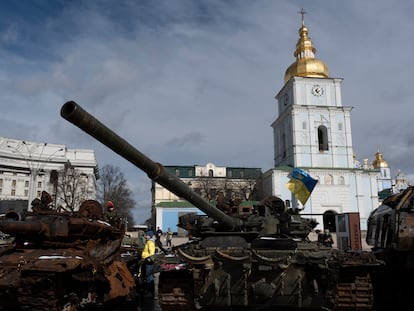Why the price of grain is giving the world a break
The Black Sea Grain Initiative has increased production, while the cost of fertilizer has declined. But experts warn the economy is ‘flying on one engine’

In a respite for global agricultural production, grain prices have fallen sharply from their highs last year in the wake of the Russian attack on Ukraine. The Food and Agriculture Organization of the United Nations (FAO)’s Cereal Price Index averaged 147.3 points in February, only two points higher than the same month in 2022, when war broke out in Ukraine and prices soared.
Current levels are well below the peak reached in May last year, when it exceeded 173 points. According to analysts, this drop is due to three main factors: improved production forecasts, the fall in the cost of fertilizers and fuel, and the agreement to export grain through the Black Sea Grain Initiative signed between Moscow and Kyiv.
The U.N. estimates that, since the initiative was signed in July last year, some 25 million tons of grain have been exported to 45 countries and world food prices have dropped by about 18%. Last week the agreement was extended for another 120 days, until July 18, which guarantees supply in the short term.
Global production forecasts are also easing pressure on the market. FAO’s forecast for 2023 is for global wheat production to be the second-highest on record at 784 million tons. The outlook for coarse grain crops, such as maize, is also favorable thanks to record plantings in Brazil and a good rainy season in Argentina.
In tandem, fertilizer prices have fallen sharply. The Green Markets Weekly North America Fertilizer Price Index has declined to $533 per short ton, after peaking at $1,270 in March last year. Despite this data, agricultural analysts warn that this is a truce that is still under threat because the Black Sea grain deal could crumble and energy volatility and climate change may also undermine crop production.
John Baffes, senior economist at the World Bank’s Prospects Group, has even acknowledged that these conditions mean the economy is “flying on one engine,” so that if any of these risks materialize there will again be a rapid rebound in prices.
The most pressing danger lies in the possibility that the export agreement between Russia and Ukraine could break down. A failure in the negotiation would block grain supplies to half of the planet. In addition, although many crops and fertilizers are exempt from European sanctions imposed on Moscow, there is a possibility that geopolitical tensions could lead to supply disruptions. If so, wheat and maize, the two main commodities that benefit from the grain deal, could return to record highs.
Looking ahead to the remainder of the year, U.S. officials expect prices to remain relatively high because global stocks of these foods are still low, according to a document released by the U.S. Department of Agriculture in February. FAO also expects world cereal stocks to decline by 1.2% at the end of 2023 compared to January due to lower production of coarse grains (maize, barley and sorghum) and rice, offsetting the increase in wheat production.
Grain shortages were the driving force behind the uptick in prices even before the war. The first blow came from previous droughts and from stockpiling by governments and companies during the Covid pandemic.
Sign up for our weekly newsletter to get more English-language news coverage from EL PAÍS USA Edition
Tu suscripción se está usando en otro dispositivo
¿Quieres añadir otro usuario a tu suscripción?
Si continúas leyendo en este dispositivo, no se podrá leer en el otro.
FlechaTu suscripción se está usando en otro dispositivo y solo puedes acceder a EL PAÍS desde un dispositivo a la vez.
Si quieres compartir tu cuenta, cambia tu suscripción a la modalidad Premium, así podrás añadir otro usuario. Cada uno accederá con su propia cuenta de email, lo que os permitirá personalizar vuestra experiencia en EL PAÍS.
¿Tienes una suscripción de empresa? Accede aquí para contratar más cuentas.
En el caso de no saber quién está usando tu cuenta, te recomendamos cambiar tu contraseña aquí.
Si decides continuar compartiendo tu cuenta, este mensaje se mostrará en tu dispositivo y en el de la otra persona que está usando tu cuenta de forma indefinida, afectando a tu experiencia de lectura. Puedes consultar aquí los términos y condiciones de la suscripción digital.
More information
Archived In
Últimas noticias
Most viewed
- Sinaloa Cartel war is taking its toll on Los Chapitos
- Oona Chaplin: ‘I told James Cameron that I was living in a treehouse and starting a permaculture project with a friend’
- Reinhard Genzel, Nobel laureate in physics: ‘One-minute videos will never give you the truth’
- Why the price of coffee has skyrocketed: from Brazilian plantations to specialty coffee houses
- Silver prices are going crazy: This is what’s fueling the rally











































